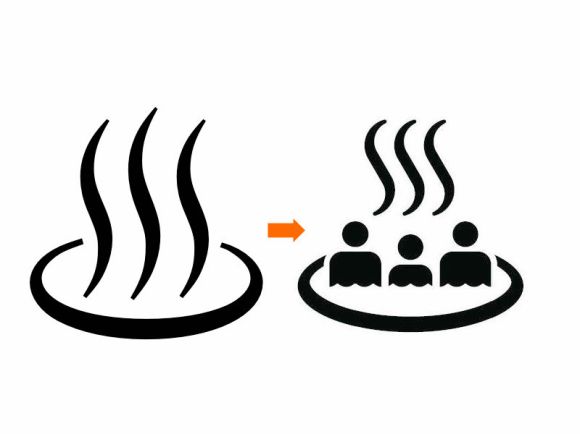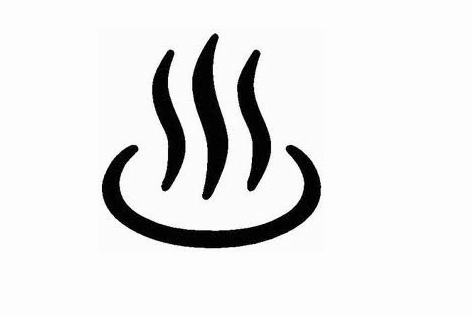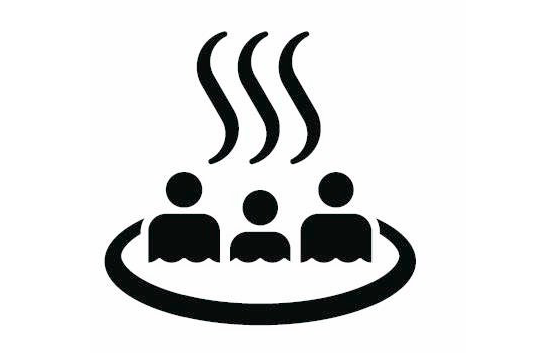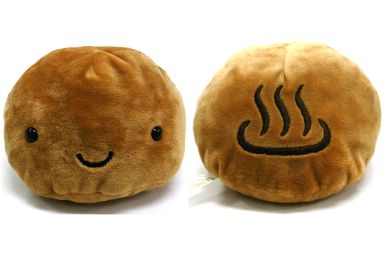
Opinions are divided over the new pictogram for hot springs.
With only four short years to go before the 2020 Tokyo Olympics, Japan is gearing up to welcome visitors from across the world with revamped stations, larger taxis, and even artificial meteor showers. One of the most recent developments, however, is dividing people in Japan, with the announcement that one of the nation’s most well-known and often used pictograms, the Japanese hot spring (“onsen” in Japanese) symbol, is up for revision.
▼ The “onsen mark” features a circular line, which represents a hot spring bath, along with three curved vertical lines resembling steam.
According to the The Ministry of Economy, Trade and Industry (METI), the symbol could be misinterpreted by foreigners as the mark of a restaurant that serves hot food. To avoid confusion, three people have been added to the onsen symbol, to clarify the fact that the image is used to represent hot spring bathing.
The revamped image, which was revealed by METI at a Japanese Industrial Standards revision committee meeting last week, is one of 70 public symbols set to appear from next summer in order to meet standards set by the International Organization for Standardization. Other pictograms up for revision include the “do not touch” symbol, which looks at changing the current raised palm image to a hand touching a flat surface with a diagonal line crossing over it, and the “information office” sign, which will be changed from a question mark to the more universally used “i” symbol. In addition, the ministry plans to create 40 new symbols for foreign tourists, to indicate Wi-Fi hotspots, ATMs that accept overseas cash cards, and prayer rooms for Muslims.
It’s the change to the onsen mark, however, that has some residents concerned, with much larger ramifications for onsen resort towns and businesses that incorporate the current symbol in their logos and products. The pictogram, for example, is used as part of the city logo for Atami, a famous hot spring town in Shizuoka Prefecture.
Atami uses the logo on its flag and city seal, with many products, souvenirs and even manhole covers in the area bearing the mark. Like Atami, other onsen towns that use the mark are now faced with the dilemma of deciding whether to use the revised symbol on their products for foreign visitors or stick to the original design.
▼ Onsen manju, soft sweet buns cooked by the steam of hot springs, are commonly stamped with the symbol, and they even have a cute character, Onsen Manju-kun, modelled after them. It’s yet to be revealed if the revision to the pictogram will affect them in the future.
Online comments in Japan regarding the proposed change to Japan’s onsen mark have included:
“I wish they would just leave the mark the way it is.”
“I’m sad about the change but I can see how it’s important to make things less confusing for foreign visitors.”“If we change symbols like this so foreigners can understand them, where’s the respect for Japanese culture?”
“Wouldn’t it have been better to add the word “onsen” in English underneath the original symbol?”
“How is this less confusing? It looks like people are being boiled to death in a big pot.”
While final revisions to the 70 symbols will be made by the end of the fiscal year in March 2017, the pictograms approved by JIS will not affect maps, but will be widely used in public spaces like buildings, train stations and tourist areas.
Sources: Ministry of Economy, Trade and Industry , NHK news , Twitter search “hot spring mark” , Tokyo Shimbun
Top image: pbs.twimg.com/Open Clip Art/Negaskun (edited by YouPouch)
Insert images: Open Clip Art/Negaskun, Wikimedia Commons/Public Domain, Sarugaya
[ Read in Japanese ]





 Japan’s government reconsiders plan to change country’s iconic hot spring symbol after backlash
Japan’s government reconsiders plan to change country’s iconic hot spring symbol after backlash Japanese government recommends changing Buddhist temple mark on maps to avoid Nazi connotations
Japanese government recommends changing Buddhist temple mark on maps to avoid Nazi connotations New onsen facility in the heart of Tokyo’s business district to be ready for Olympics
New onsen facility in the heart of Tokyo’s business district to be ready for Olympics Japan’s Harajuku Station to be rebuilt ahead of 2020 Tokyo Olympics
Japan’s Harajuku Station to be rebuilt ahead of 2020 Tokyo Olympics Stylish new Experience Japan Pictograms are here to enhance your Japan travels and knowledge
Stylish new Experience Japan Pictograms are here to enhance your Japan travels and knowledge Station of despair: What to do if you get stuck at the end of Tokyo’s Chuo Rapid Line
Station of despair: What to do if you get stuck at the end of Tokyo’s Chuo Rapid Line Japanese government will check and judge new baby name pronunciations, presents guidelines
Japanese government will check and judge new baby name pronunciations, presents guidelines This downtown Tokyo cafe is like a time machine that takes you back 50 years into the past
This downtown Tokyo cafe is like a time machine that takes you back 50 years into the past Totoro towels gently glow in the dark to set the Ghibli nighttime mood in your home【Photos】
Totoro towels gently glow in the dark to set the Ghibli nighttime mood in your home【Photos】 Clever design trick means beautiful Ghibli Artboard Jigsaw Puzzles won’t have bittersweet ending
Clever design trick means beautiful Ghibli Artboard Jigsaw Puzzles won’t have bittersweet ending Evangelion and McDonald’s Japan launch first-ever collaboration with transforming figures【Video】
Evangelion and McDonald’s Japan launch first-ever collaboration with transforming figures【Video】 Cup Noodle sells new squid fork with its instant ramen
Cup Noodle sells new squid fork with its instant ramen Nakano Broadway sells a fukubukuro lucky bag for foreigners, but is it a good deal or a scam?
Nakano Broadway sells a fukubukuro lucky bag for foreigners, but is it a good deal or a scam? Starbucks Japan releases a new Frappuccino that looks and tastes like a floral bouquet
Starbucks Japan releases a new Frappuccino that looks and tastes like a floral bouquet Studio Ghibli showcases traditional craftsmanship with new wallet range
Studio Ghibli showcases traditional craftsmanship with new wallet range Japanese company develops classy heavy metal band frames for glasses
Japanese company develops classy heavy metal band frames for glasses One of Japan’s rarest sweets is a sell-out hit that looks and tastes like frost
One of Japan’s rarest sweets is a sell-out hit that looks and tastes like frost Mysterious light-up rainy night-sound Totoro figure doesn’t actually show a scene from the anime
Mysterious light-up rainy night-sound Totoro figure doesn’t actually show a scene from the anime Major Japanese city is abolishing extracurricular activities at all of its middle schools
Major Japanese city is abolishing extracurricular activities at all of its middle schools Over 800 Studio Ghibli anime world paintings compiled in beautiful new hardcover art book【Pics】
Over 800 Studio Ghibli anime world paintings compiled in beautiful new hardcover art book【Pics】 Spirited Away and Princess Mononoke plushies show a softer side of formidable Ghibli characters
Spirited Away and Princess Mononoke plushies show a softer side of formidable Ghibli characters Shakey’s is back! All-you-can-eat pizza chain returns to downtown Tokyo’s Shinjuku
Shakey’s is back! All-you-can-eat pizza chain returns to downtown Tokyo’s Shinjuku Studio Ghibli tea blends contain ingredients inspired by My Neighbour Totoro
Studio Ghibli tea blends contain ingredients inspired by My Neighbour Totoro Possessing Harry Potter’s Sword of Godric Gryffindor is now illegal in Japan
Possessing Harry Potter’s Sword of Godric Gryffindor is now illegal in Japan Uniqlo announces first-ever collaboration with horror manga master Junji Ito【Photos】
Uniqlo announces first-ever collaboration with horror manga master Junji Ito【Photos】 J-pop mega star Ado reveals she’s been living in the U.S., may not understand language acquisition
J-pop mega star Ado reveals she’s been living in the U.S., may not understand language acquisition Starbucks Japan is calling it quits with paper straws
Starbucks Japan is calling it quits with paper straws Studio Ghibli releases new range of cardigans for anime fans
Studio Ghibli releases new range of cardigans for anime fans Japan’s most popular castle raising ticket prices by up to 200 percent for non-local tourists
Japan’s most popular castle raising ticket prices by up to 200 percent for non-local tourists Furikake rice seasoning sales are soaring, which is bad news for Japan as a whole
Furikake rice seasoning sales are soaring, which is bad news for Japan as a whole Studio Ghibli heroine cardigans give you warmth and strength to face everyday challenges
Studio Ghibli heroine cardigans give you warmth and strength to face everyday challenges Eight unforgettable hot springs, as recommended by Japan’s “Professor Bath”
Eight unforgettable hot springs, as recommended by Japan’s “Professor Bath” McDonald’s new Happy Meals offer up cute and practical Sanrio lifestyle goods
McDonald’s new Happy Meals offer up cute and practical Sanrio lifestyle goods Foreign tourists on Shinkansen bullet train break suitcase etiquette, angering local passengers
Foreign tourists on Shinkansen bullet train break suitcase etiquette, angering local passengers [Deleted] Article written for April Fool’s Day 2018
[Deleted] Article written for April Fool’s Day 2018 Japanese government to make first change to romanization spelling rules since the 1950s
Japanese government to make first change to romanization spelling rules since the 1950s Foreigner’s request for help in Tokyo makes us sad for the state of society
Foreigner’s request for help in Tokyo makes us sad for the state of society Japanese convenience store Family Mart announces abolishment of eat-in spaces
Japanese convenience store Family Mart announces abolishment of eat-in spaces Life-size vibrating Legend of Zelda Master Sword for sale from Nintendo【Photos】
Life-size vibrating Legend of Zelda Master Sword for sale from Nintendo【Photos】 Princesses, fruits, and blacksmiths: Study reveals the 30 most unusual family names in Japan
Princesses, fruits, and blacksmiths: Study reveals the 30 most unusual family names in Japan Studio Ghibli releases free-download board game — Here’s how to play it without reading Japanese
Studio Ghibli releases free-download board game — Here’s how to play it without reading Japanese This balding middle-aged fairy is one of Japan’s most unique mascot characters
This balding middle-aged fairy is one of Japan’s most unique mascot characters Japan Airlines giving foreign travelers 100,000 free round-trip tickets during the Tokyo Olympics
Japan Airlines giving foreign travelers 100,000 free round-trip tickets during the Tokyo Olympics Japanese lawyer comments on legality of tattoo ban at hot springs, netizens share thoughts too
Japanese lawyer comments on legality of tattoo ban at hot springs, netizens share thoughts too 18 awesome overnight hot spring trips from Tokyo, and a quiz to help pick the best one for you
18 awesome overnight hot spring trips from Tokyo, and a quiz to help pick the best one for you Learn all about enjoying a traditional Japanese-style ryokan inn from this nine-minute video!
Learn all about enjoying a traditional Japanese-style ryokan inn from this nine-minute video! Kyoto may be getting more modern, tall buildings as city relaxes development limits
Kyoto may be getting more modern, tall buildings as city relaxes development limits Japanese government encouraging hot springs to ease tattoo restrictions
Japanese government encouraging hot springs to ease tattoo restrictions Japanese mayor responds to public after “spamusement park” onsen video reaches 1 million views
Japanese mayor responds to public after “spamusement park” onsen video reaches 1 million views Naomi Osaka chooses Japanese citizenship over U.S., hopes to represent Japan at Tokyo Olympics
Naomi Osaka chooses Japanese citizenship over U.S., hopes to represent Japan at Tokyo Olympics Onsen town’s 4K video has visitors lining up around the virtual block【Video】
Onsen town’s 4K video has visitors lining up around the virtual block【Video】 The top 10 hot springs Japanese travelers want to visit this fall
The top 10 hot springs Japanese travelers want to visit this fall Gravure model NFT series wants to attract online investors, real-world visitors for hot springs
Gravure model NFT series wants to attract online investors, real-world visitors for hot springs Eight unforgettable hot springs, as recommended by Japan’s “Professor Bath”
Eight unforgettable hot springs, as recommended by Japan’s “Professor Bath” Ridiculously powerful hot spring bath in Japan earns both our respect and our fear【Videos】
Ridiculously powerful hot spring bath in Japan earns both our respect and our fear【Videos】 Pikachu and Super Mario left out of lineup of official spokescharacters for Tokyo Olympics
Pikachu and Super Mario left out of lineup of official spokescharacters for Tokyo Olympics
Leave a Reply